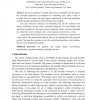Free Online Productivity Tools
i2Speak
i2Symbol
i2OCR
iTex2Img
iWeb2Print
iWeb2Shot
i2Type
iPdf2Split
iPdf2Merge
i2Bopomofo
i2Arabic
i2Style
i2Image
i2PDF
iLatex2Rtf
Sci2ools
IDMS
1997
Springer
1997
Springer
Embedding Data in 3D Models
The recent popularity of digital media such as CD-ROM and the Internet has prompted exploration of techniques for embedding data, either visibly or invisibly, into text, image, and audio objects. Applications of such data embedding include copyright identification, theft deterrence, and inventory. This paper discusses techniques for embedding data into 3D models. Given objects consisting of points, lines, (connected) polygons, or curved surfaces, the algorithms described in this paper produce polygonal models with data embedded into either their vertex coordinates, their vertex topology (connectivity), or both. A description of the background and requirements is followed by a discussion of where, and by what fundamental methods, data can be embedded into 3D polygonal models. The paper then presents several data-embedding algorithms, with examples, based on these fundamental methods.
| Added | 08 Aug 2010 |
| Updated | 08 Aug 2010 |
| Type | Conference |
| Year | 1997 |
| Where | IDMS |
| Authors | Ryutarou Ohbuchi, Hiroshi Masuda, Masaki Aono |
Comments (0)

